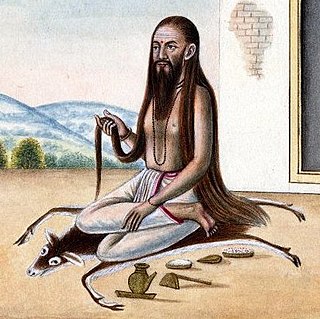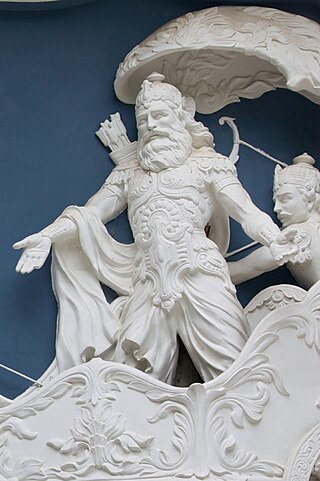
In Indian religions, a rishi is an accomplished and enlightened person. They find mentions in various Vedic texts. Rishis are believed to have composed hymns of the Vedas. The Post-Vedic tradition of Hinduism regards the rishis as "great yogis" or "sages" who after intense meditation (tapas) realized the supreme truth and eternal knowledge, which they composed into hymns. The term appears in Pali literature as Ishi; in Buddhism they can be either Buddhas, Paccekabuddhas, Arahats or a monk of high rank.

Angiras or Angira was a Vedic rishi (sage) of Hinduism. He is described in the Rigveda as a teacher of divine knowledge, a mediator between men and gods, as well as stated in other hymns to be the first of Agni-devas. In some texts, he is considered to be one of the seven great sages or Saptarishis, but in others he is mentioned but not counted in the list of seven great sages. In some manuscripts of Atharvaveda, the text is attributed to "Atharvangirasah", which is a compound of sage Atharvan and Angira. The student family of Angira are called "Angira", and they are credited to be the authors of some hymns in the first, second, fifth, eighth, ninth, and tenth books of the Rigveda. By the time of the composition of the Rigveda, the Angirases were an old Rishi clan, and were stated to have participated in several events.

Bharadvaja was one of the revered Vedic sages (maharishi) in Ancient India. He was a renowned scholar, economist, grammarian, physician and a follower of Maha Pashupata. He is one of the Saptarishis.

Bhrigu was a rishi in Hinduism. He was one of the seven great sages, the Saptarshis, and one of the many Prajapatis created by Brahma. The first compiler of predictive astrology and also the author of Bhrigu Samhita, an astrological (jyotisha) classic. Bhrigu is considered a manasaputra ("mind-born-son") of Brahma. The adjectival form of the name, Bhargava, is used to refer to the descendants and the school of Bhrigu. According to Manusmriti, Bhrigu was a compatriot of and lived during the time of Manu, the progenitor of humanity. Along with Manu, Bhrigu had made important contributions to the Manusmriti, which was constituted out of a sermon to a congregation of saints in the state of Brahmavarta, after the great floods in this area. As per the Skanda Purana, Bhrigu migrated to Bhrigukaccha, modern Bharuch, on the banks of the Narmada river in Gujarat, leaving his son Chyavana at Dhosi Hill.

Kshatriya is one of the four varnas of Hindu society and is associated with the warrior aristocracy. The Sanskrit term kṣatriyaḥ is used in the context of later Vedic society wherein members were organised into four classes: brahmin, kshatriya, vaishya, and shudra.

The historical Vedic religion, also known as Vedicism and Vedism, constituted the religious ideas and practices prevalent amongst the Indo-Aryan peoples of the northwest Indian subcontinent during the Vedic period. These ideas and practices are found in the Vedic texts, and some Vedic rituals are still practiced today. The Vedic religion is one of the major traditions which shaped Hinduism, though present-day Hinduism is significantly different from the historical Vedic religion.

Vishvamitra is one of the most venerated rishis or sages of ancient India. Vishvamitra is one of the seven Brahmarshi. According to Hindu tradition, he is stated to have written most of the Mandala 3 of the Rigveda, including the Gayatri Mantra (3.62.10). The Puranas mention that only 24 rishis since antiquity have understood the whole meaning of —and thus wielded the whole power of — the Gayatri Mantra. Vishvamitra is supposed to have been the first, and Yajnavalkya the last.
In Hinduism, a Brahmarshi is a member of the highest class of Rishis. A Brahmarshi is a sage who has attained enlightenment and became a Jivanmukta by completely understanding the meaning of Brahman and has attained the highest divine knowledge, infinite knowledge (omniscience) and self knowledge called Brahmajnana. When a Brahmarshi dies he attains Paramukti and frees himself from Samsara, the cycle of birth and death.
Havyaka Brahmins also and originally called Havika Brahmana are a Hindu Brahmin community native to districts of Shivamogga,Uttara Kannada, Dakshina kannada and coastal Karnataka, and the Kasaragod district of Kerala. Havyakas are known by their unique culture and language. They fall under the Pancha-Dravida Brahmin category are followers in general of mostly Yajurveda and some Rigveda and Samaveda Shakas. They follow the Advaita philosophy propounded by Adi Shankaracharya.
In Hindu culture, the term gotra is considered to be equivalent to lineage. It broadly refers to people who are descendants in an unbroken male line from a common male ancestor or patriline. Generally, the gotra forms an exogamous unit, with marriage within the same gotra being regarded as incest and prohibited by custom. The name of the gotra can be used as a surname, but it is different from a surname and is strictly maintained because of its importance in marriages among Hindus, especially among castes. Pāṇini defines gotra as apatyam pautraprabhrti gotram, which means "the word gotra denotes the descendance, apatya, of a couple consisting of a pautra, a son and a bharti, a mother, i.e. a daughter-in-law."
In the Vamsa Brahmana of Vedic literature, Aupamanyava is listed as a Vedic sage and teacher of the Sama Veda.

The Saptarshi are the seven seers of ancient India who are extolled in the Vedas, and other Hindu literature such as the Skanda Purana. The Vedic Samhitas never enumerate these rishis by name, although later Vedic texts such as the Brahmanas and Upanisads do so.
The name Gautam is one of the ancient Indian names and is derived from the Sanskrit roots "gŐ(गः)" and "tama (तम)". "Tama" means "darkness" and "gŐ" means inter alia "bright light". Together they indicate one, who dispels darkness by his brilliance.
Abhivadaye is a religious practice among Hindu men to introduce themselves to others especially the elders. It is practiced even today widely among the Brahmins.
Rajopadhyaya is one of Newar Bramhans in Nepal.

Kamrupi Brahmins, also known as Kamarupi Brahmana and Kamrupi Bamon; are those brahmins who claimed their descent from the Kanauji Brahmins and Maithili Brahmins who settled in Kamarupa. They brought with them different Hindu epics and became the torch-bearers of Indo-Aryan culture in the region.
Avatsara is a rishi (sage) featured in the Rigveda. His name first appears in Sukta 44 of the Fifth Mandala.

A Hindu Gotra is an exogamous unit used to denote the paternal lineage of individuals belonging to the Brahmin in the Hindu Varna system. In Hindu culture, the Brahmin considered to be one of the four major social classes of the Varna system. In Sanskrit, one of the meanings of the word Gotra is “a descendant through an unbroken patriline”. According to Hindu scripture, members of the Hindu community are believed to have descended from the first seven Sanatan saints of the Vedic period. A Gotra represents the lineage of an individual saint and a Brahmin’s Gotra denotes which of these saints is their ancestor.
Savarna or Savarni/Shavarna is a Brahmin gotra that comprises Kanyakubja Brahmins and Saryupareen Brahmins who are the descendants of sage Savarna Muni. The origins of Savarna gotra can be traced back to the origins of Kanyakubja Brahmins in Kannauj, Uttar Pradesh.











